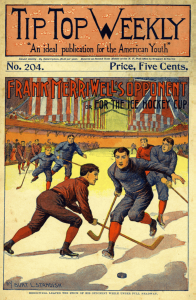
Another Amazing Frank Merriwell Victory for Yale!
Unless you are a true nerd of America’s juvenile series heroes of the early 1900s, I’m sure your first question is, “Who in the world is Frank Merriwell?” If you were a good bit older, you would surely know.
I’m working on a book titled In Search of Yesterday’s Heroes which will fully answer that question, but now, to keep it short, Frank was the fictional, young, ultra-clean living, magnanimous and virtuous sports hero of literally millions of young readers, eventually tens of millions, if you consider that, by 1931, across three and a half decades, publishers estimated that America was home to half a billion Frank Merriwell books. In his 1971 Rascals At Large book, Arthur Prager quotes 125 million readers over two decades. Hard to believe that we no longer know Frank.
Frank was so popular, some sports announcers actually thought he was real. Any spectacular feat that won a sporting event during the first decades of the 20th Century was announced to be “a Merriwell finish.”
If an activity was anything close to a sport, Frank played it and played it better than anyone else. A young Ronald Reagan thrilled to the gridiron miracles of Frank Merriwell, who began his Tip Top Weekly series life on April 18, 1896, published by Street & Smith and written every week, for some 20 years with occasional respite, by Gil Patten under the name Burt L. Standish. As Frank’s popularity grew, weeklies were also compiled into hardback books.
Frank had an ever-exciting, world-traveling career, but when in college, he was a Yale man. Numerous students went to Yale because of Frank.
On March 10, 1900, Frank’s Yale ice hockey team went against the rival Princeton team in Tip Top 204 (5 cents) titled Frank Merriwell’s Opponent or For the Ice Hockey Cup. As always, it would be a thriller and countless young breaths were bated, awaiting the story’s arrival in the mail. Soon, they would read 11 new chapters that would end:
But in making that blow Heath gave Merriwell an advantage. He had struck in desperation, feeling that he was going to be defeated if he could not cripple Merry so that Frank would be forced from the ice and out of the game. But Merry fought on as if nothing had happened, and with the puck in his possession began to hurry it toward the Princeton flags.
Again he found himself opposed by Brandon Heath. Once more the struggle was between these two chiefly. Heath drove the puck back, when he found he could not get possession and snap it to one of the Princeton forwards; but it came down the ice again, sent by Danny Griswold, and Merry once more got hold of it. Then he swiftly and cleverly “lifted” it right over the stick of Brandon Heath.
Merry was skating like the wind as he did it, and before Heath could make a movement, Merriwell leaped the stick of his opponent while under full headway. Then he lifted the puck again, and sent it between the Princeton flags!
Such a roar as went up! It was simply indescribable. Time had expired, and the game and the ice hockey cup belonged to Frank Merriwell’s team, with a score of three for Yale and one for Princeton. There had not been even a second of time to spare, for the referee’s warning sounded, and the game was over. “Merriwell! Merriwell!” was shouted on all sides.
 The 1980 Miracle on Ice That Began to Melt the Cold War
The 1980 Miracle on Ice That Began to Melt the Cold War
It was February 22, 1980. The TV was on NBC and the XIII Winter Olympic Games at Lake Placid, New York, and the final-four medal round of the ice hockey teams was heating up.
The USA and the Soviet Union were on the ice in the final period of play. The USA boys ~ all college guys like Frank ~ had come from behind 3-2 to tie the score at 3-3. With 10 minutes to go, team captain Mike Eruzione of Boston University scored to make it 4-3, USA. The world held its collective breath.
This was the same-o, frustrating, amateur vs. “professional” contest we Cold War babies in America were used to. We all knew that Soviet athletes, whether gymnasts or hockey players, were essentially government-supported and trained professionals. Who could beat ‘em?
Our American Olympians stuck to the rules you can find spelled out in the 1964 Olympic Charter Eligibility Rules of the IOC. The International Olympic Committee would accept only amateurs supporting themselves with an occupation and having received no material gain of any sort or amount for sport participation, ever, period. Sport could be an avocation only. (Except in the good ol’ USSR.)
How serious was the IOC about this rule? In 1912, a very real “Frank Merriwell” ~ American track star Jim Thorpe of the Sac and Fox tribe of Oklahoma ~ won gold in Sweden in both the pentathlon and decathlon. Miraculous!
But Jim had received money for playing minor-league baseball in 1909-10. He was stripped of his medals, and his records remain unofficial to this day, though the IOC began opening the door, gradually, to professional players with tennis in 1988, basketball in 1992, hockey in 1998, boxers in 2016.
The Soviet Hockey Goliaths
The 1980 Soviet hockey team held four gold medals since 1964, with no Olympic loss since 1968. They were considered to be the best in the world, the greatest team ever. Only three days before, they had whipped the USA team 10-3 in a Madison Square Garden exhibition game, and observers thought the USA team actually did pretty well with a “scrappy” performance.
The Americans were seeded seventh, but coach Herb Brooks brought his talented and highly conditioned young athletes into the four-team medal round undefeated with four wins and one tie. Now, it was 10 minutes to go on the clock and these young amateurs had an impossible, one-point lead over hockey’s legendary team. The Americans hung on to that lead and won, and the world went crazy, including me.
Just as sports announcers half a century before yelled, “It’s a Merriwell finish!” announcer Al Michaels called out, “Do you believe in miracles? Yes!”
And it became the Miracle on Ice. It was just like David vs. Goliath, like the American Revolution, like Israel in 1948. It just wasn’t supposed to happen.
But it wasn’t over. Two days later, Finland stood in the way of the gold, but not for long. USA won 4-2.
Why Was It So Important?
Since World War II, and the mid-fifties specifically, the U.S. and the new Union of Soviet Socialist (note the “Socialist”) Republics had been at war ~ a Cold War we called it, since we had yet to blow one another to smithereens with nuclear weapons. On that issue, I grew up with bated breath and the view of my neighbor’s backyard bomb shelter.
After the Communist Revolution of 1917, the Russians had, by 1922, put together 15 “republics” into the Union of Soviet Socialist Republics (USSR). They grabbed the Baltic states, the “stans,” and the Russian surrounds. Then, after WWII, our suddenly former allies grabbed Poland, Czechoslovakia, Hungry, Romania, Bulgaria, half of Germany, and half of Berlin, leaving one half of the German capital an isolated bastion of freedom.
So, now we had an East Germany that everyone wanted to leave and a West Germany where most of them wanted to go, as well as an East Berlin and a West Berlin. And, because the new “socialist” East was so wonderful, soon there was a Berlin Wall that people would die to cross.
I knew about our 1948 Berlin Airlift to save the West section, the 1956 violent put down by the Soviets of the brave Hungarian Revolution, and the launch of Sputnik in 1957. I literally sat through the 1962 Cuban Missile Crisis in a Houston school desk, awaiting evacuation by school bus which, thankfully, never came about. I shuddered reading the 1959 nuclear apocalyptic novel Alas Babylon, then laughed and giggled at the 1966 movie, The Russians Are Coming, The Russians Are Coming. By 1966, the edge of getting blown to smithereens had dulled a little. We had “chilled” for over 10 years.
Beating the Russians to the Moon in 1969 was an important, exhilarating, and inspiring victory. So was beating the Russian ice hockey “giants” with our virtuous, amateur, “Frank Merriwell” USA Olympic team in 1980. By the end of that year, Ronald Reagan would be President, the Iranian hostages would be released, and only nine years remained until the fall of that Berlin Wall and the collapse of the communist USSR.
Frank and Gil Patten would have been proud.
References:
Cranfill, S. A., In Search of Yesterday’s Heroes ~ A Journey to Meet the Young Hearts of Yesterday ~ 1890s to 1960s (to be released 2020); NBCsports.com; https://www.history.com/this-day-in-history/u-s-hockey-team-makes-miracle-on-ice, Feb. 22, 2020; https://www.smithsonianmag.com/history/why-are-jim-thorpes-olympic-records-still-not-recognized-130986336/ Sally Jenkins, Smithsonian Magazine, July 2012; https://www.elitedaily.com/p/can-professional-athletes-compete-in-the-olympics-heres-the-deal-8120567 Hannah Golden Feb 5, 2018

